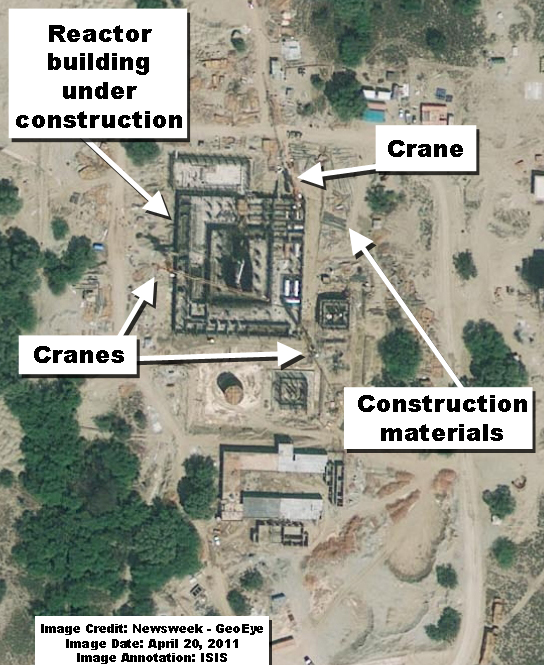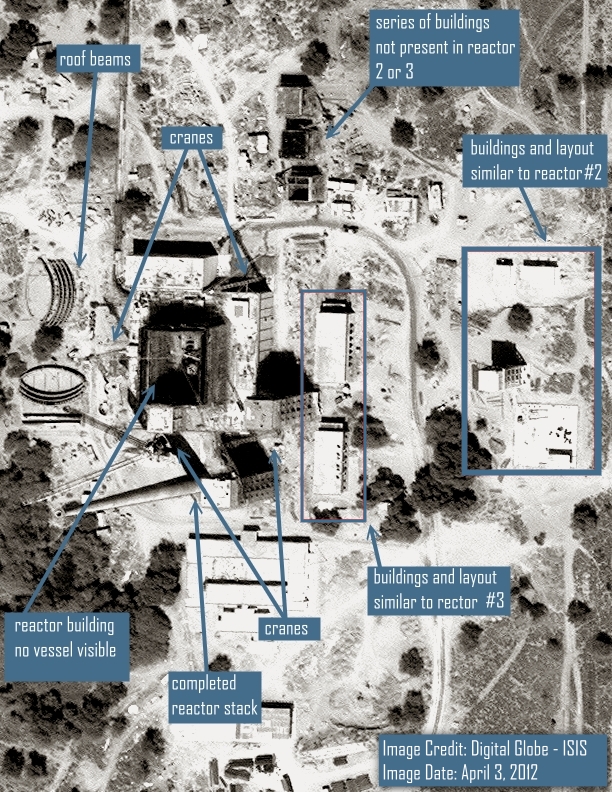Reports
Construction Progressing Rapidly on the Fourth Heavy Water Reactor at the Khushab Nuclear Site
by David Albright and Robert Avagyan
May 21, 2012
Construction of the fourth Khushab reactor and supporting buildings is progressing with the reactor building about halfway to completion. The fourth reactor, located 200 kilometers south of Islamabad, is the latest addition to the Khushab nuclear site and is dedicated to the production of plutonium for nuclear weapons. In addition to the fourth reactor, the Khushab site includes two reactors similar in shape to the fourth one, a heavy water production plant, and an original, nominal 50 megawatt-thermal (MW-th) heavy water reactor completed in 1998 (see figure 1). The completion of the fourth Khushab reactor would constitute a significant increase in Pakistan’s ability to make plutonium which appears related to its goal of building a large number of smaller nuclear weapons.
This increase in plutonium production represents a growing nuclear arms race between India and Pakistan. In order to avoid a dangerous escalation, the United States and the international community should increase efforts to convince Pakistan to stop blocking negotiations of the Fissile Material Cutoff Treaty (FMCT) at the Geneva Conference on Disarmament. India and Pakistan should be convinced to stop further production of plutonium and highly enriched uranium for nuclear weapons and cap their stocks of these dangerous materials, thereby limiting the number of nuclear weapons each side can produce. To motivate Pakistan to accept a FMCT, the United States should consider incentives that could include China’s provision of additional civil nuclear power reactors.
Increase in Security at Site
Satellite imagery shows that security at all sites of the Khushab nuclear complex appears to have been increased. Wider security perimeters have been added around all four reactor facilities as well as the heavy water plant (see figure 1). The added security features seem to be a measure against increasingly bold and targeted attacks by militant groups against Pakistani military facilities, most notably the May 2011 assault on a Pakistani naval air base.
Fourth Reactor
The latest imagery shows the fourth reactor building under construction with the inside of the reactor building still visible (see figure 2). The reactor vessel is not visible in this image. Arched roof beams identical to those used for reactors 2 and 3 have been placed near the construction site in preparation for the covering of the reactor building.
The construction of several nearby buildings and structures appears complete. The completion of the reactor stack is notable. There are now two clearly defined perimeters around the fourth reactor construction site with the outer perimeter resembling the adjoining complex containing reactors 2 and 3.
Although the size of the reactor 4 complex is similar to the complex containing reactors 2 and 3, there are differences in the layout and types of buildings being constructed around the reactor itself (see figures 1, 2, and 4). The reason for these differences in not known. It is also unknown whether Pakistan plans to build a fifth reactor next to the fourth reactor just as it did in the case of reactors 2 and 3.
Based on the available imagery ISIS estimates that the construction of the fourth reactor is proceeding about 30 percent faster than construction on reactor three and that major external work could be complete within fifteen months. Predicting when the fourth reactor will become operational is much more difficult since a lack of external construction does not preclude work inside the building and because satellite imagery provides limited indications as to its operational status.
Figure 1. Wide area view of the Khushab nuclear complex showing the new security perimeters around all three major sites in the complex and a comparison between the reactor 2 and 3 facility and the reactor 4 facility.
Figure 2. Close up of fourth Khushab reactor showing progress on the construction of the reactor building. Nearby buildings share some similarites with the buildings at the reactor 2 and 3 complex while some portions appear to be part of a new layout.

Figure 3. Close up of earlier construction on the fourth Khushab reactor from April 20, 2011.

Figure 4. Close up of the completed reactors 2 and 3. There is no visible steam coming from the cooling units. Steam would be an indication of the reactor operating but its absence does not mean that they are not operational. The heat dissipation may not be creating steam due to atmospheric conditions.



 twitter
twitter